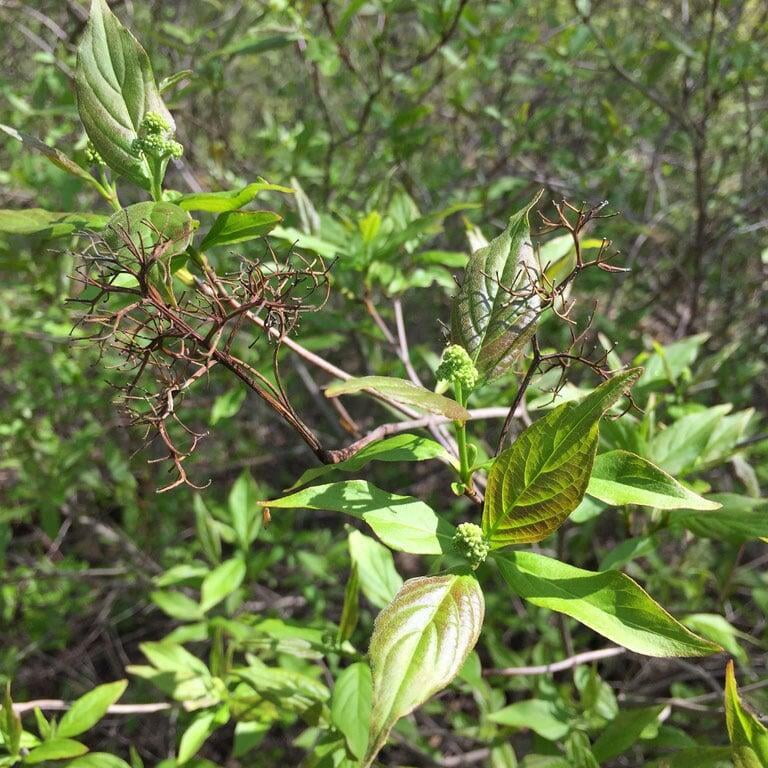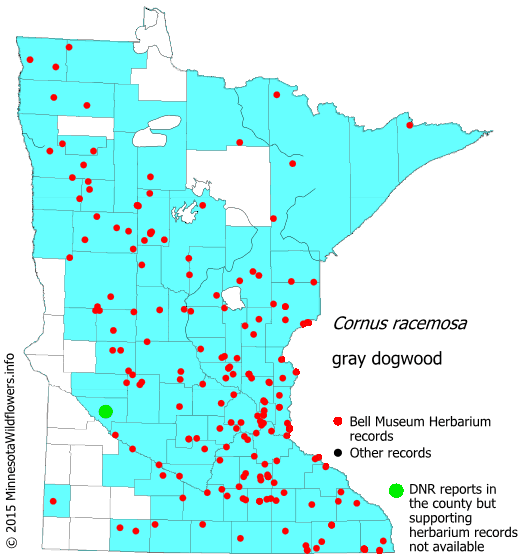Cornus racemosa
Gray dogwood description:
Cornus racemosa, commonly known as the gray dogwood, is a deciduous shrub that belongs to the dogwood family, Cornaceae. It is native to North America and can be found growing in various habitats, including woodlands, thickets, and stream banks. The gray dogwood is a hardy and low-maintenance shrub that typically grows up to 8 feet in height and width. It has multiple stems with brownish-gray bark and dense, twiggy branches that provide cover for wildlife. The leaves of the gray dogwood are oval-shaped, pointed at the tip, and have a slightly wavy edge. They are dark green in color during the summer, turning reddish-purple in the fall. In the spring, the shrub produces clusters of small, white flowers that give way to blue-black berries in the fall. These berries are an important food source for birds and other wildlife during the winter months. The gray dogwood is a great choice for landscaping, as it is low-maintenance and provides year-round interest. It can be propagated through cuttings or seed, and benefits from regular pruning to promote healthy growth.
Native Range:
Gray dogwood is found in the Midwest and Eastern United States. It's range is from North Dakota and Minnesota south to Arkansas, and East to Main and the Carolinas.
Standard Plant Information:
Plant Height: 3-8'
Bloom time: June - July
Preferred Habitat: Does well in part shade to full sun with average moisture soil. Often found in open woods, woodland edges, savannas, fields, thickets, and roadsides.
Planting:
Planting a tree/shrub seedling or small potted tree/shrub properly is important to ensure its healthy growth and development. Here are the steps you can follow to plant a tree:
Choose the right spot: Select a spot with adequate sunlight, water, and soil drainage. Make sure the tree has enough space to grow to its full size without interfering with other plants, structures, or utility lines.
Prepare the soil: Dig a hole that is twice as wide and slightly shallower than the root ball of the seedling. Remove weeds or debris from the area. Loosen the soil around the edges of the hole to help the roots grow more easily.
Plant the seedling: Place the seedling in the hole, making sure the top of the root ball is level with the ground surface. Gently spread out the roots and fill in the hole with soil, tamping it down lightly as you go.
Water the seedling: Water the tree/shrub deeply and thoroughly after planting, making sure the soil is evenly moist. This will help settle the soil around the roots and eliminate any air pockets.
Monitor the growth: Keep an eye on the seedling to make sure it is getting enough water and sunlight, and that it is not being attacked by pests or diseases. Prune any damaged or dead branches as necessary, and provide support if needed.
By following these steps, you can help ensure the healthy growth and development of your newly planted tree/shrub seedling.



maps used with permission from MN Wildflowers
Cornus racemosa Gallery









